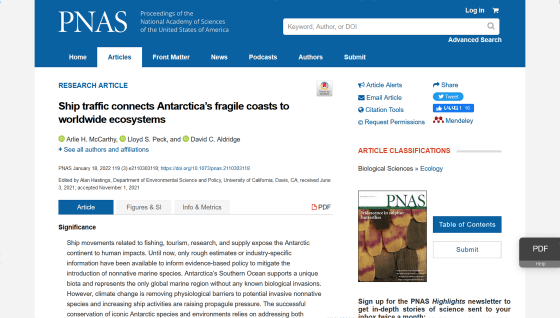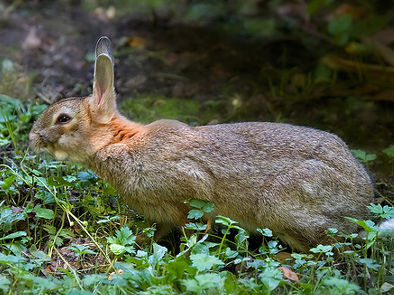Antarctica's precious ecosystem is threatened by alien species carried by human ships

by
Antarctica has been relatively isolated from the outside world for millions of years, creating a unique ecosystem unlike any other. However, in recent years, alien species that have invaded with the advance of humans into Antarctica are at risk of threatening existing ecosystems, explains Early McCarthy , a postdoctoral fellow at the University of Cambridge.
Ship traffic connects Antarctica's fragile coasts to worldwide ecosystems | PNAS
https://www.pnas.org/content/119/3/e2110303118

Antarctica's unique ecosystem is threatened by invasive species'hitchhiking' on ships
https://theconversation.com/antarcticas-unique-ecosystem-is-threatened-by-invasive-species-hitchhiking-on-ships-174640
The simplest way to prevent the destruction of ecosystems by alien species is to 'prevent alien species from entering', and Antarctica, which has not been settled by humans for a long time, has maintained its own ecosystem. rice field. In addition, there is an eastward recirculation called the Antarctic Circumpolar Current in the waters around Antarctica, and with a few exceptions such as whales, whales, and migratory birds, it is difficult for marine organisms to reach Antarctica. matter.
This natural barrier has existed for millions of years, but human ships can reach Antarctica and its coasts, allowing alien species carried with them to invade Antarctica. McCarthy pointed out that it became. It is said that it takes up to 3 years for species attached to kelp etc. drifting from the New Zealand Subantarctic Islands to reach the South Pole, but a human ship can reach the South Pole in just a few days from the Subantarctic Islands. Is possible.
McCarthy investigated the alien species that inhabit the hull of ships visiting Antarctica and also investigated the routes that the ships take. According to McCarthy's research, ships visiting the South Pole include mussels, crabs, barnacles, amphipods (crustaceans including gammaridea), bryozoa (bryozoa) , hydroins (animals similar to sea anemones and jellyfish), and seaweeds. Since the hull is cleaned only once every few years, there is a good possibility that these alien species will invade the Antarctic continent.
Also, looking at the chart below showing the routes of ships that visited Antarctica from 2014 to 2018, the ships pass through ports around the world, and there is a risk that various alien species will invade Antarctica. I understand.

Most ships to the South Pole pass through five port cities:
In order to prevent alien species from being brought into the Antarctic by ships passing through ports around the world, special coatings that prevent animals and algae from sticking to the hull are applied to the hull, the hull is cleaned less frequently, and the water is moved to the Antarctic waters. Measures such as inspecting whether the hull has been cleaned before entering can be mentioned. These measures increase the number of logistics-related processes, but have already been introduced in Hawaii, the Galapagos Islands, New Zealand, Australia, etc. to prevent the introduction of alien species.
The number of ships visiting Antarctica is said to have increased up to 10 times since the 1960s to 100 to 200 ships each year, with access concentrated in the Antarctic Peninsula and the South Shetland Islands , and these areas are the most exotic. It is said that it is in danger of seeds. The breakdown of ships visiting Antarctica is 67% for tourism, 21% for research, 7% for fishing, 5% for transportation of goods, and 1% for others, and they access all areas of the continent. Seems to be only a ship for research purposes.

by gregpoo
Researchers have identified a total of five non-native species such as mussels and crabs as 'alien species brought into the Antarctic Ocean by human hands' so far. Since mussels and crab-like animals do not exist around Antarctica, there are concerns that mussels will establish a habitat that is prosperous for other alien species, and that crabs will eat native species. It has been. However, it is unclear whether these animals will survive in the Antarctic environment in the long run and what impact they will actually have on the ecosystem.
'At this point, the Antarctic and Antarctic Oceans are the least invaded marine regions on the planet and are the last chance to demonstrate that we can manage and mitigate the risks of continentally invasive species,' McCarthy said. He warned that if humans do not work together to prevent the invasion of alien species, the precious ecosystems of Antarctica will change.
Related Posts:







